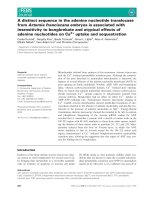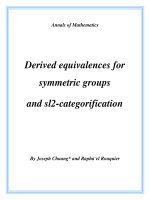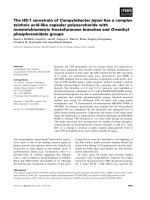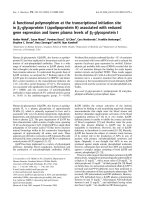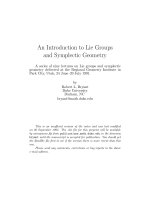Groups with prescribed quotient groups and associated module theory world scientific (2002)
Bạn đang xem bản rút gọn của tài liệu. Xem và tải ngay bản đầy đủ của tài liệu tại đây (9.22 MB, 245 trang )
ALGEBRA
GROUPS WITH PRESCRIBED
QUOTIENT GROUPS AND
ASSOCIATED MODULE
THEORY
L. Kurdachenko
J. Otal
I. Subbotin
World Scientific
GROUPS WITH PRESCRIBED
QUOTIENT GROUPS AND
ASSOCIATED MODULE
THEORY
www.pdfgrip.com
SERIES IN ALGEBRA
Editors: J. M. Howie, D. J. Robinson, W. D. Munn
Vol. 1: Infinite Groups and Group Rings
ed. J. M. Corson et al.
Vol. 2: Sylow Theory, Formations and Fitting Classes in Locally
Finite Groups
M. Dixon
Vol. 3: Finite Semigroups and Universal Algebra
J. Almeida
Vol. 4: Generalizations of Steinberg Groups
T. A. Fournelle and K. W. Weston
Vol. 5: Semirings — Algebraic Theory and Applications in Computer Science
U. Hebisch and H. J. Weinert
Vol. 6: Semigroups of Matrices
J. Okninski
Vol. 7: Partially Ordered Groups
A. M. W. Glass
Vol. 8: Groups with Prescribed Quotient Groups and
Associated Module Theory
L. Kurdachenko, J. Otal and I. Subbotin
Vol. 9: Ring Constructions and Applications
A. V. Kelarev
www.pdfgrip.com
GROUPS WITH PRESCRIBED
QUOTIENT GROUPS AND
ASSOCIATED MODULE
THEORY
L. Kurdachenko
Dnepropetrovsk University, Ukraine
J. Otal
Universidad de Zaragoza, Spain
I. Subbotin
National University, California, USA
âWorld Scientific
lb
New Jersey ã London • Singapore • Hong Kong
www.pdfgrip.com
Published by
World Scientific Publishing Co. Pte. Ltd.
P O Box 128, Fairer Road, Singapore 912805
USA office: Suite IB, 1060 Main Street, River Edge, NJ 07661
UK office: 57 Shelton Street, Covent Garden, London WC2H 9HE
British Library Cataloguing-in-Publication Data
A catalogue record for this book is available from the British Library.
GROUPS WITH PRESCRIBED QUOTIENT GROUPS AND ASSOCIATED
MODULE THEORY
Copyright © 2002 by World Scientific Publishing Co. Pte. Ltd.
All rights reserved. This book, or parts thereof, may not be reproduced in any form or by any means,
electronic or mechanical, including photocopying, recording or any information storage and retrieval
system now known or to be invented, without written permission from the Publisher.
For photocopying of material in this volume, please pay a copying fee through the Copyright
Clearance Center, Inc., 222 Rosewood Drive, Danvers, MA 01923, USA. In this case permission to
photocopy is not required from the publisher.
ISBN 981-02-4783-4
Printed in Singapore by Uto-Print
www.pdfgrip.com
To Tamara, Marisol, and Milla
www.pdfgrip.com
This page is intentionally left blank
www.pdfgrip.com
Preface
One of the most effective ways to study groups is to evaluate the weight different
related subjects have on them. Examples would include considering its subgroups
or specific systems of these subgroups (such as normal, subnormal, almost
normal, permutable, pronormal, and abnormal subgroups), special subgroups
(such as centralizers, normalizers, permutizers), different conjugate classes,
groups of automorphisms, rings of endomorphisms of abelian groups, and so on.
Undoubtedly, different natural families of factor-groups (quotients) have an
important role in this study. For example, the role of the family of finite
factor-groups in different algorithmic problems of finitely presented groups (see,
for example, [MA, KM, RRN]), in the theory of the varieties of groups [NH], is
well known. The same family plays a relevant role in the study of polycyclic
groups. The first result, which illustrated the direct influence of the system of all
finite factor-groups on the structure of polycyclic groups, was the following
Hirsch's theorem: if every finite factor-group of a polycyclic group G is nilpotent,
then G is nilpotent [HOC]. The further investigation of the influence of the system
of all finite factor-groups on the structure of polycyclic groups has been
developed in different ways and brought many interesting and important results
(see, for example, [GPS 1, GPS 2, GS 1, GS 2, GS 3, PP 1, PP 2] and also the
book [SD 2]). It has naturally initiated the interest in the study of such influence
on the structure of the finitely generated soluble groups. D. J. S. Robinson has
obtained a significant amplification of Hirsch's theorem. He proved the following
classical result: if every finite factor-group of a finitely generated soluble (even
hyperabelian) group G is nilpotent, then G is nilpotent [RD 8]. A similar result
has been obtained by D. J. S. Robinson for another class of soluble groups: for
residually finite minimax soluble groups [RD 4]. In this association it is important
to note that a finitely generated soluble group of finite abelian section rank is
minimax (D. J. S. Robinson [RD 18]). Following the result of A. Mann and D.
Segal [MS, Theorem A], finitely generated soluble-by-finite minimax groups can
be characterized thorough the family of all finite factor-groups in the following
Vll
www.pdfgrip.com
Vlll
Preface
way: a finitely generated residually finite group G is minimax and
soluble-by-finite if and only if there is a number r such that every finite
factor-group of G has a (special) rank at most r. Note that D. Segal [SD 3] has
considered the influence of some finite factor-groups on the structure of residually
finite soluble groups (see, also [DSMS]). Observe also, that research related to
different generalizations of this Robinson's theorem, have been launched in the
papers [SD 1, ZD 4, BJR 1, BJR 2, BJS]. It is important to admit that this theorem
cannot be extended to the property of supersolubility. In other words, there exists
a finitely generated soluble group, every finite factor-group of which is
supersoluble, but the group itself is not supersoluble (D. Segal [SD 1]).
We also would like to point out the role of the factor-groups by some special
subgroups. The Frattini subgroup Fratt[G) of a group G is one of the most
influential in this direction. If the Frattini factor-group GIFratt(G) of a finitely
generated soluble group G is finite, supersoluble or polycyclic, then so is G [LJ 1,
LJ2.LJ3].
A significant number of investigations in Group Theory is connected with the
consideration of factor-groups by centralizers of different G - invariant subsets.
Let G be a group and S its G - invariant subset (that is gx e S for every g e S
and every x e G). Then CQ(S) is a normal subgroup of G. The factor-group
GlcG{S) = COCQ{S) is called the cocentralizer of the set 5 in the group G. The
group COCG(S) is isomorphic with some subgroup of Aut{< S >G ). The influence
of the cocentralizers of many objects connected to a group on the structure of the
group is a subject of study in many domains of the Group Theory. Finite Group
Theory developed many examples where cocentralizers of chief factors play a
great role. We can see it particularly in Formations Theory (note that the local
formations are defined by restrictions on cocentralizers of chief factors). Classes
of infinite groups, which arise by restriction on cocentralizers of conjugacy
classes, are studied.
Let X be a class of groups. A group G is called an XC - group if
Cocdg0) e X for each g e G.
If X= .Fis the class of all finite groups, then we obtain the well-known class of
FC - groups. The class of FC- groups is an extension of the class T of all finite
groups and of the class A of all abelian groups as well (A is exactly the class of
IC - groups where / is the class of all identity groups). Therefore they inhered
many properties of both of these classes. Currently, the theory of FC - groups
forms a well developed topic and represents one of the main branches of the
Infinite Groups Theory ( see the books [RD 9, GY, CS 2, TM 1] and the updated
survey [TM 2]). B. H. Neumann [NB 1] considered an interesting subclass of FC
- groups. He studied the groups with the following properties: \G : CG(X)\ < n (or
\COCG(XG)\ < n\) for all elements x e G. These groups are called BFC - groups.
B. H. Neumann has proved that BFC - groups are precisely the groups with finite
derived subgroups (orfinite-by-abeliangroups). In connection with this result the
following problem arises. Let G be a group, put b(G) = max{\G : Cc(g)| I
g e G} and suppose that b(G) is finite. Are the numbers b{G) and |[C?,G]| in
relation ? A whole series of interesting articles have been dedicated to defining of
www.pdfgrip.com
Preface
IX
this connection (see [BI, CM, MI, NP, NPV-L, V-L, SS, WI1, WI 2].
If X = C is the class of all Chernikov groups, then we obtain the class of
groups with Chernikov conjugacy classes or CC- groups. Ya. D. Polovitsky in
[PY] introduced this class and obtained some initial results. Although CC - groups
are not investigated as far as FC - groups, they are the subject of many recent
papers (see [AO, FdeGT 2, GO 1, GO 2, OP 1, OP 2, OPT] and others).
The study of XC - groups for other important classes X has only recently begun
(see [FdeGK 1, FdeGT 1, KL 4, KL 6, KSU 1]).
The widest family of the factor-groups of a group G is the family of all its
proper factor-groups. If H is a non-identity normal subgroup of G, then GIH is
said to be a proper factor-group. Let X be a class of groups. A group G is called a
just non-A" -group if every proper factor-group of G belongs to X , but G £ X .
This book is entirely devoted to just non-A' -groups, and describes techniques and
methods of study in detail. It also presents the most recently developed results of
the theory for several most important choices of the class X.
The structure of the just non-^t -groups has been already studied for many
natural classes of groups X . The first important research here is due to M. F.
Newman [NM 1, NM 2], who considered the just non-abelian groups. The second
crucial step in this direction was the consideration of just infinite groups (more
properly, just non-finite groups), which has been realized by D. McCarthy [McC
1, McC 2] and J. S. Wilson [WJ 2]. Just infinite groups, which are near to soluble
groups have been considered in [McC 1, McC 2]. In [WJ 2], J. S. Wilson
considered a general situation. The characteristics properties of these groups
obtained in this paper could be used for investigation of the structure of some
interesting examples of finitely generated periodic groups such as the Grigorchuk
group or the Gupta - Sidki group, the study of which is very intensive recently.
The next step is connected to the notion of a T- group. The class of the groups
in which normality is a transitive relation (r-groups) has been studied well by
now. These groups and some of their generalizations have been investigated by
many authors ([AI, AK, BT, GW, RD 1, RD 5, MF 1, MF 2, ZG] and many
others). The most valuable results about T-groups have been obtained by D. J. S.
Robinson in [RD 1], This work, together with the works mentioned above,
established the wide variety of interesting and important results, placing T-groups
and their generalizations in the main stream of study of the normal structure of
groups (see, for example, the survey [RD 24].) In [RD 11] D. J. S. Robinson has
described soluble just non-r-groups. This class of groups had some peculiar
properties. If just non-abelian groups were monolithic, and the infinite groups
were non-monolithic, then both of these situations meet combined already in the
study of just non-r-groups.
All studies that followed were connected with distinct extensions of the class
A of all abelian groups, and of the class T of all finite groups as well. Thus J. R.
J. Groves [GJ], and D. J. S. Robinson and J. S. Wilson [RW] considered soluble
groups with polycyclic or supersoluble proper factor-groups. The paper [RW],
which is very rich with new ideas, constructions and results, took a remarkable
place in the theory of just non-X -groups, and determined in many different ways
www.pdfgrip.com
X
Preface
the further development of this theory. In particular, it showed the meaning of the
module theoretical methods for the study of the just non-A" -groups. The key role
ofjust infinite modules has been demonstrated in this paper.
Dual to the class of polycyclic groups is the class of Chernikov groups (the
polycyclic groups can be characterized as soluble groups with maximal condition;
the Chernikov groups can be characterized as soluble-by-finite groups with
minimal condition). The groups with Chernikov proper factor-groups have been
considered by S. Franciosi and F. de Giovanni [FdeG 1], and also by L. A.
Kurdachenko, V. E. Goretsky and V. V. Pylaev [KGP]. In the article [KSU 4] L.
A. Kurdachenko and I. Ya. Subbotin investigated the more general case when all
proper factor-groups are hyperfinite (obviously all Chernikov groups are
hyperfinite).
The next important step was made in the paper of D. J. S. Robinson and Z.
Zheng [RZ], in which they described just non-(central-by-finite)-groups and just
non-(finite-by- abelian)-groups (or just non-BFC-groups). Both classes,
central-by-finite groups and finite-by-abelian {BFC - groups), are extensions of
finite groups and abelian groups. On the other hand, both of these classes are
proper subclasses of FC - groups. Therefore, the study of just non-FC-groups (S.
Franciosi, F. de Giovanni, L. A. Kurdachenko [FdeGK 3]) seems very natural in
this direction. The papers of L. A. Kurdachenko and J. Otal [KO 1, KO 2, KO 3],
in which just non-CC-groups have been studied, followed after. The other natural
restrictions of the class A are the classes Nc, the class of nilpotent groups of
nilpotence class < c, and N, the class of all nilpotent groups. S. Franciosi and F.
de Giovanni [FdeG 2] considered the just non-A^-groups and just non-nilpotent
groups. A slight generalization of this situation was considered by Z. Zhang [ZZ],
L. A. Kurdachenko and I. Ya. Subbotin in their paper [KSU 3] initiated the
important investigation of just non-hypercentral groups.
The main goal of this book is to provide the systematic and complete
exposition of the main results of the theory of just non-A" -groups. We expose the
material in a way that allows us to describe the oldest and newest results from a
common point of view. Such an approach is determined by the following
circumstances, which in general define the main content of the book.
First, let's talk about some important restrictions. Clearly, if G is a simple
group, then G is a just non-X-group for each class of groups X. This means that
the study of just non-Af -groups requires some additional restrictions allowing us
to avoid this situation. Therefore, as in most papers about just non-X -groups, we
will only consider such groups G whose Fitting subgroup Fitt(G) is non-identity.
We recall that Fitt(G) is the subgroup generated by all normal nilpotent
subgroups of G; so the condition Fitt{G) * < 1 > is equivalent to the condition
for G to include a non-identity normal abelian subgroup.
Also, this approach is determined by possibilities to apply Module Theory. Let
G be a just non-A"-group. For many important classes X the investigation of G is
very often split into two parts according to the following two alternatives:
FC{G) * < 1 > and FC(G) = < 1 > (here F(G) is the FC-center of a group G).
The study of the first case, when FC{G) * < 1 >, usually is realized with no
www.pdfgrip.com
Preface
XI
problems. Therefore, the case FC(G) = < 1 > is the most interesting one. For
almost all considered classes X, the subgroup Fitt(G) = A is abelian; moreover,
it is either an elementary abelian p - subgroup for some prime p or an abelian
torsion-free subgroup. Then the group H = GIA naturally acts on A by
conjugation and this action gives raise to A into a ZH - module. This shows that
the study of just non-A'-groups requires the study of some types of modules over
the group rings.
Let V be a family of all non-identity G - invariant subgroups of A, M = f]V.
Obviously M can be identity or not, and the study of G is very dependent on it.
Therefore, there is a need to split the study into two cases:
( M ) M * < 1 >,
and
(N-M) M = < 1 >.
In the case (M) the subgroup Mis the monolith of the group G; in particular, M
is a simple ZH - module. For many important classes X in the monolithic case
A = M, in other words, A is a simple ZH - module. Thus, the first important type
of modules that arises in research of just non-X -groups is the class of simple
modules. This type of module has arisen already in the first paper dedicated to
this theme, in the paper of M. F. Newman [NM lj. Hence, one of our tasks will be
the study of simple modules over ^-groups, which will be carried out in several
chapters of this book. These modules play a key role not only in the study of the
just non-A"-groups but also in other issues of Group Theory (see, for example, the
survey [KZK]). Other related questions will also be considered.
Recall that an infinite module^ is said to be just infinite, if it is non-monolithic
and every one of its proper submodules has finite index. In the case (N-M) (the
non-monolithic case) just infinite modules play a very important role. These
modules have been introduced in the important paper of D. J. S. Robinson and J.
S. Wilson [RW]. Further research has shown that these modules are crucially
important to the study of just non-X -groups and for many different important
classes X of groups.
The first modular part of this book is completely determined by the arguments
above. It will be devoted to considerations of simple and just infinite modules
over some important types of groups. Moreover, we want to consider modules
over the ring RH where R is some "good" extension of the both rings Z and
Wp < g > where < g > is an infinite cyclic group, which are especially important
for group-theoretic applications. This extension was carried out by considering a
Dedekind domain as such a ring. We recall that a Dedekind domain is a
noetherian integrally closed domain, in which every non-zero prime ideal is
maximal.
When we are thinking about extending the theory of abelian groups on the
modules, we have to bear in mind that these extensions involve the coefficients
ring and occur step by step, from result to result. Many results that are valid for
the ring Z are also valid for many of its wide ring extensions This is a good
justification of the introduction of the most important classes of commutative
www.pdfgrip.com
Xll
Preface
rings: principal ideal domains, Dedekind domains, valuation domains, integral
domains and so on (at this point, the comments from the chapters of [FL 1,FL 2]
and [FLS] are useful). Many years of experience proved that Dedekind domains
have appeared in the most achieved generalizations of the Abelian Group theory.
To be more specific, they form the widest class of integral domains, to which the
main results from Abelian Group Theory can be extended; moreover, these
analogies produce new characterizations of this class. Therefore, in the sequel, we
will consider modules over a group ring DG, where D is a Dedekind domain.
The module part is key part of the study of all such types of just non- X -groups
that are considered in this book. However, this investigations are not exhausted by
the research of corresponding modules. Along with some general elements of
structure, each class of groups considered in the book has its own specific
individual characteristics and, therefore, requires an individual consideration.
This book includes a relatively large theoretical part of the group, in which we
try to expose most important known results from our point of view in this area.
The mentioned restrictions and the limited size of the book do not allow us to
provide all existing information, however, we try to reflect the information as
completely as possible in the bibliography.
The authors want to express their deepest gratitude to D. J. S. Robinson, whose
results and methods exercised significant influence on the authors' interest in the
theme. They also treasure very much his extremely valuable comments and his
inspiration during the process of preparing this book.
Also they would like to mention the names of the prominent scholars, whose
personal influences, tests, and encouragements played a key role in the formation
of the authors as mathematicians. Unfortunately, these wonderful people passed
away some time ago, but the memory of them still supports the authors throughout
the hard way of mathematical research. They are S. N. Chernikov, D. I. Zaitsev
and Z. I. Borevich.
We would like to thank World Scientific Publishing Co, Pte Ltd for the great
opportunity to publish this book in its famous Algebra Series. We really treasure
personal help and encouragement, which came from the Commissioner Editor A.
Doyle and from the Scientific Editor J. T. Lu.
Scott McClintock and Karen Offitzer helped us tremendously with the editing.
This work would never have been completed without the great support of
National University, U. S. A. and Zaragoza University, Spain. The authors are
very thankful for that.
www.pdfgrip.com
Contents
Preface
vii
Notation
xv
I
Simple Modules
1.
On Annihilators of Modules
2.
The Structure of Simple Modules over Abelian Groups
3.
The Structure of Simple Modules over Some Generalization of
3
17
Abelian Groups
25
4.
Complements of Simple Submodules
39
II
Just Infinite Modules
5.
Some Results on Modules over Dedekind Domains
47
6.
Just Infinite Modules over FC-Hypercentral Groups
61
7.
Just Infinite Modules over Groups of Finite 0-Rank
77
8.
Just Infinite Modules over Polycyclic-by-Finite Groups
91
9.
Co-Layer-Finite Modules over Dedekind Domains
101
III Just Non-^-Groups
10. The Fitting Subgroup of Some Just Non-^-Groups
109
11. Just Non-Abelain Groups
115
12. Just Non-Hypercentral Groups and Just Non-Hypercentral Modules
121
13. Groups with Many Nilpotent Factor-Groups
131
14. Groups with Proper Periodic Factor-Groups
143
15. Just Non-(Polycyclic-by-Finite) Groups
155
16. Just Non-CC-Groups and Related Classes
165
17. Groups Whose Proper Factor-Groups Have a Transitive Normality
Relation
181
Bibliography
203
Author Index
221
Subject Index
225
www.pdfgrip.com
This page is intentionally left blank
www.pdfgrip.com
Notation
AnriR(a) 3
Annit(A) 3
tn{A) 3
Spec(D) 4
n0(a) 4
n0(^) 4
^/ 4
nUA) 4
r*(<4) 6
/•o(G) 11
AT(G) 28
QX 28
fto* 28
AfCooCG) 28
FC{G) 28
FC„o(G) 28
Qsoc{G) 32
5oc a 6 (G) 32
S„A" 69
P # 69
H(G)
109
www.pdfgrip.com
xvi
HRG{A)
PRGiA)
Notation
122
122
www.pdfgrip.com
Parti
Simple Modules
As usual, a module A is said to be simple, if A does not include proper
non-zero submodules.
As its title indicates, this part, formed by four chapters, is devoted to
studying the existence and the structure of the simple modules over certain
group rings, an important tool in the study of the structure of the groups in
consideration.
1
www.pdfgrip.com
This page is intentionally left blank
www.pdfgrip.com
Chapter 1
On Annihilators of Modules
Let R be an integral domain. If A is an ^-module and a & A, the annihilator of a
is AnnR(a) = {x e R \ ax = 0}, an ideal of R. The annihilator ofA is
AnnR(A) = {x e R \ ax = 0 for every a e A} = |~)a&4 AnnR(a).
Let G be a group, A a simple 7?G - module. If / is an ideal of D, then AI is a
Z)G - submodule. Therefore either AnnR(A) * < 0 > or AI = A for any non-zero
ideal /, in particular, Ax = A for every 0 * * e /?. In the first case it is not
difficult to prove that AnnR(A) = P is a maximal ideal of#, and we can consider
A as an FG - module where F = RIP is a field. In the second case A is an R divisible module. Hence we can consider A as a KG - module where K is the field
of fractions for the ring R. Consequently, the following question makes sense and
appears at first:
When isAnnR(A) non-zero"?
The first important result has been obtained here by P. Hall. In the paper [HP
2] he proved that if G is polycyclic and R = Z, then Annz{A) * < 0 > . In the
paper [BR 3] R. Baer obtained a similar result for the case, when G is a locally
finite group. D. I. Zaitsev successfully generalized both these results in the paper
[ZD 3], where he considered a very useful union of the classes of polycyclic
groups and locally finite groups. We are giving here some slight extension of the
Zaitsev's theorem (see [KPS 1]).
Let R be an integral domain, A a module over R. Put
tR{A) = {a e A\ AnnR(a) * < 0 >}.
3
www.pdfgrip.com
4
Simple Modules
It is easy to see that tR(A) is an R - submodule.
A submodule tR(A) is called the R - periodic part of A. A is said to be an R periodic module if A = tR(A). A is said to be an R - torsion -free if tR (A) =
< 0 >.
Note that A/IR(A)
is R - torsion - free.
Let now D be a Dedekind domain, Spec(D) = {P | P is a maximal ideal of D}.
If aetD(A),
then AnnD(a) = P1?1... P?' for some Pu... ,PS e SpecD,
Pi =£ Pj and this decomposition is unique (see, for example [KG, Chapter 3,
Theorem 3.5]). PutLT D (a) = {Pu... ,PS} and Y\D{A) = L U o W n D ( a ) .
Let it c Spec(D). We say that A is a n- periodic module if A is D - periodic
andYloiA) £ n.
Let I be an ideal ofD. Put
Ai = {a e A | al" = < 0 > for some n e N}.
Clearly, Ai is a D- submodule of A.
AD- submodule Aj is called the I - component of A. If A = Aj, then A is
called an I- module.
Put
Qi,k(A) = {a e A | alk = < 0 >>
It is easy to see that Qj^(A) is a D- submodule and
Q/,i04) < Q/,204) < ••• < nitiA)
< ...,
We will need some "primary" decomposition of D - periodic modules (see, for
example, E. Matlis [ME]).
1.1. Proposition Let D be a Dedekind domain, A a D - module, B a submodule
of A. If A is D -periodic, then
A
= BPeSpec(D)Apand(A/B)P
for any P e Spec{D).
www.pdfgrip.com
= (AP + B)/B
On Annihilators of Modules
5
P. Hall [HP 2] introduced a very useful class of modules over principal ideal
domains, which appear very often in studies of noetherian modules over some
group rings. Here we will give a little extension of some Hall's results on modules
over Dedekind domains.
Let n £ Spec{D). We say that a D - module A belongs to the class A(D, n) if A
includes a projective D - submodule B such that AIB is n -periodic.
Then, the relationship appears to be very clear: as it is well-known, over
principal ideal domains projective modules are free (see, for example, [PD 2,
Theorem 6.3 and Corollary 6.4]). Thus our next result extends [HP 2, Lemma 4.2]
and [HP 2, Lemma 4.3].
1.2. Lemma Let D be a Dedekind domain, n c SpecD, A aD - module.
(1) If A e A(A, K), B is aD- submodule of A, then B e A(D, it).
(2) If A has an ascending chain ofD - submodules
< 0 > = A0
< ...Ar = A
e A{A,n) for any a < y, then A e A(A, n).
Proof
(1) Since A e A{A,n), A includes a projective D - submodule Ao such
thatA/Ao is K - periodic. From B/(BC\Ao) = {B + Ao)/Ao < A/Ao we obtain that
B/(B n AQ) is n - periodic. Since D is a Dedekind domain, this yields that AQ f) B
is a projective D - submodule (see, for example, [PD 2, Theorems 6.3 and 7.7]),
and our result is following from it.
(2) We proceed by transfinite induction on a and show that Aa e A{A,K) for
each a < y. It is obvious for a = 1. We will assume that we have already proved
that^/j e A(A,K)
for all B < a.
If a is not a limit ordinal, then there exists a - 1, and Aa-\ includes a projective D
- submodule Ca-\ such thatv4 0 -i/C 0 -i is n - periodic. Similarly AJAa-\ includes
another projective D - submodule C/Aa-\, and (AalAa-\)l{CIAa-\)
is n- periodic
too. The protectiveness of the latter implies the decomposition C = Aa-\ © E for
some D - submodule E (see, for example, [PD 2, Lemma 6.1]). Since E is
projective, Ca-\ © E is projective too. The corresponding factor-module
AJ{Ca-\ © E) is an extension of a n- periodic submodule CI{Ca-\ ® E) =
(Aa-i © E)/(Ca-\ © £ ) = Aa-\ICa-\ by a n - periodic module AJC, so that it is
also ^--periodic.
Now we assume that a is a limit ordinal. Then Ap includes a projective D submodule Cp such that Ap/Cp is jr-periodic. As above it is possible to choose
these modules such that Cp < Cp+\ and Cp+i/Cp is projective. Then, their union
Ca = \Jp
www.pdfgrip.com
6
Simple Modules
corresponding factor-module A JCa has an ascending chain
04 1 + Ca)ICa < ...(Af, + Ca)ICa < (Ap+l + Ca)ICa < ... ,
whose factors (Ap + Ca)ICa = Apl{ApC\Ca) = AplCp are n- periodic for
each p < a.lt readily follows t h a t ^ a / C a is also n - periodic. For a = y we obtain
that .4 e A(D,n).
1.3. Lemma Let D be a Dedekind domain, P e Spec{D), A a D - periodic
module. If"P £ UD(A), then A = AP.
Proof Proposition 1.1 yields that A = © p e n u)^Q where AQ is the Q component of A. Therefore it is sufficient to prove that (AQ)P = AQ. If a e AQ
then Annoifl) = Qk for some k e N. Let x e P\Q. Since Q is a maximal ideal,
xD + Q = D. It is not difficult to prove that xD + Qk = D, thus 1 = xu + v where
u e D,v e Qk. Therefore
a = a\
= aux + av = {au)x
s (Ag)x
Consequently, (AQ)P =AQ for every Q e YID(A),
<
(AQ)P.
hence AP = A.
1.4. Lemma Let R be a ring and let I be a right ideal ofR, A an R - module, B
an R - submodule of A. Then (A/B)I = (AI+ B)IB.
1.5. Corollary Let Rbe a ring and let I be a right ideal ofR, AanRBanR- submodule of A. If{AIB)I * AIB, then AI ± A.
module,
Let R be an integral domain. Given an 7?-module A, a subset S £ A is said to be
R -free if it spans a free submodule SR = ®xeSxR of A. It is known that maximal
R - free subsets S of A have the same cardinal |51 (see, for example, [PD 2,
Lemmas 2.3 and 2.6]), which is called the R-rank of the module A and denoted by
rn(A). Concerning this idea, the following lemma shows how this invariant can be
calculated for the modules we are considering.
1.6. Lemma Let D be a Dedekind domain, it c Spec(D), P e Spec(D)\x, A a
D - module, and suppose that A is not D-periodic. If A e A(D,K),
then ro(A) =
dimD/P(A/AP).
Proof Let C be a projective D - submodule of A such that AIC is it - periodic.
Since A is not periodic, C * < 0 >. It means that C = © A e A Cx where Cx is D isomorphic with some ideal Ix of the ring D, X e A (see, for example, [PD 2,
Theorem 7.7]). It follows that CP = 0 A e A CxP, and therefore
www.pdfgrip.com
On Annihilators of Modules
C/CP s 0 , E A C , / C A P S
1
Q ^ h l h P .
The D - modules h/I\P and Z)/P are isomorphic (see, for example, [KG,
Chapter 3, Corollary 3.15]) for every X e A. Consequently, we may write
CICP =
®X^F,
where all £> - modules F), are isomorphic with DIP. In particular,
dimD/P(CICP) = |A|. Since ^ / C is D - periodic, rD(A) = r£>(C). Clearly,
ro(C) = |A|, hence we deduce immediately that ro{A) = dimoipiCICP).
Since P £ UD(A/Q, C/CP is the P-component of A/CP, in particular,
A/CP = C/CP ® B/CP for some D - submodule B. Moreover, B/CP = A/C, that is
P £ UD(B/CP).
By Lemma 1.3 (B/CP)P = fi/CP. It follows that
(A/CP)P = B/CP, in particular, ^ P < B. On the other hand, CP < AP n C,
therefore by Lemma 1.4
B/CP = (A/CP)P = (.4P + CP)/CP = ylP/CP,
and, therefore, B = AP. Hence
A/AP = A/B = (A/CP)/(B/CP) = (C/CP © BICP)I(BICP) = C/CP.
Consequently, ro(A) = dimoipiCICP) = diniD/p(A/AP).
Now we are ready to present the following result, that is an analogy of [HP 2,
Lemma 5.1]. The proof is the same.
1.7. Theorem Let D be a Dedekind domain, G a polycyclic-by-finite group, B a
right ideal of group ring DG. Then the D - module DGIB belongs to the class
A(D,K) for some finite subset K £ Spec(D).
Proof
Let
< 1 > = G0
<...
be a subnormal series with finite or infinite cyclic factors. We proceed by
induction on its length n. If n = 0 then G = < 1 > and DG = D, so the result is
obvious.
Let n > 0 and put H = G„-\. Suppose first that GIHis finite. If {x\,...,Xk} is a
transversal to H in G, then we can write the following decomposition
DG = (DH)x\ © ... © (DH)xk.
www.pdfgrip.com
8
Simple Modules
Choose the DH- submodules ,4, of DG as follows:
A0 = B,Aj = A1-1 + (DH)Xi, 1 < i < k.
Then we have a finite series of DH- submodules between I and DG:
B = A0
A,IAi-i = {(DH)x,+A^yAt-i
=
(DH)X,I((PH)X,C[AL-I).
It is easy to see that the mapping
dxt + {{DH)Xi n^,-i) ->• d +
(DHnAt-iixi)-1)
is a DH - isomorphism. By the induction hypothesis for every index i
DH/iDHDAi-xiXj)-1) e A{D,m)
for some finite subset w, C Spec(D). Lemma 1.2 yields thaty4 e A(D,n) where
K = K\ U ••• U 7T/fc.
It remains to consider the case, in which GIH = < xH > is infinite cyclic.
Again, we came to a decomposition of DG in a direct sum of £>#-submodules,
DG
= ®„^{DH)x" .
We define recursively
RQ = < 0 >,R2m = ®.m+l^m(DH)xJ,R2m+l
= ®_mijSm{DH)x\
meN
By construction, these submodules satisfy the following equalities
Rim = Rim-x © (DH)xm, R2m+] = {DH)x-m © R2m
Let B„=B + R„. Then B„ < B„+u and \JneNB„ = DG,
B„IB„-i ={B + R„)I{B + /?„_!) s R„I(R„ n {B + R„-i)) = RJ{Rn-\
+{B^R„)).
Every element/ e R2m fl S can be uniquely expressed in the form
/ = X-m+i<,<m cJxJ> w h e r e ci £DH,-m+\
www.pdfgrip.com





